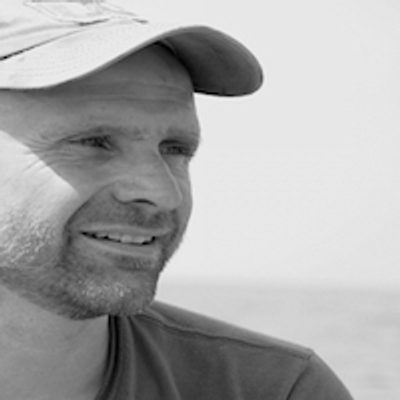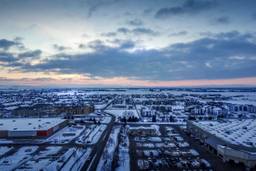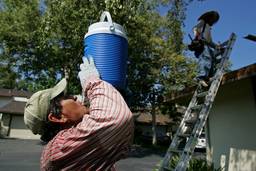An Army of Ocean Farmers: On the Frontlines of the Blue-Green Economic Revolution
Bren Smith
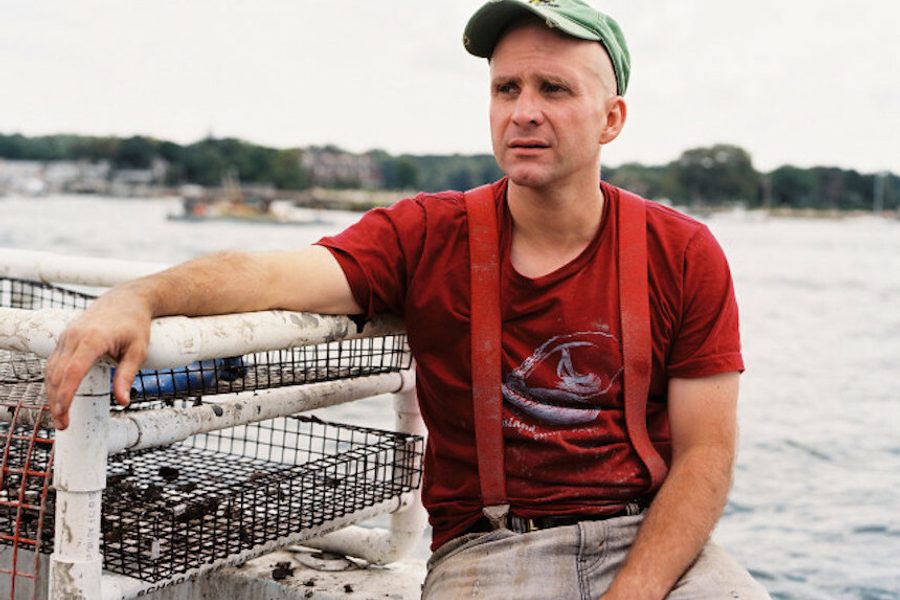
I’m a fisherman who dropped out of high school in 1986 at the age of 14. Over my lifetime, I’ve spent many nights in jail. I’m an epileptic. I’m asthmatic. I don’t even know how to swim. This is my story. It’s a story of ecological redemption.
I was born and raised in Petty Harbour, Newfoundland, a little fishing village with 14 salt-box houses painted in greens, blues and reds so that fishermen could find their way home in the fog. At age 14 I left school and headed out to sea. I fished the Georges Banks and the Grand Banks for tuna and lobster, then headed to the Bering Sea, where I fished cod and crab. The trouble was I was working at the height of the industrialization of food. We were tearing up entire ecosystems with our trawls, chasing fish further and further out to sea into illegal waters. I personally have thrown tens of thousands of pounds of by-catch back into the sea.
It wasn’t just that we were pillaging. Most of my fish was going to McDonald’s for their fish sandwiches. There I was, still a kid, working one of the most unsustainable forms of food production on the planet, producing some of the most unhealthy food on the planet. But God how I loved that job! The humility of being in 40-foot seas, the sense of solidarity that comes with being in the belly of a boat with thirteen other people working 30-hour shifts, and a sense of meaning and pride in helping to feed my country. I miss those days so, so much.
But then in the early 1990s the cod stocks crashed back home: thousands of fishermen thrown out of work, boats beached, canneries shuttered. This situation created a split in the industry: the captains of industry, who wanted to fish the last fish, were thinking 10 years down the road, but there was a younger generation of us thinking 50 years out. We wanted to make our living on the ocean. I want to die on my boat one day — that’s my measure of success.
So we all went on a search for sustainability. I ended up in Northern Canada on an aquaculture farm. At that point aquaculture was supposed to be the great solution to overfishing, but when I got there I found more of the same, only using new technologies to pollute local waterways with pesticides and pumping fish full of antibiotics. We used to say that what we were growing was neither fish nor food. We were running the equivalent of Iowa pig farms at sea.
So I kept searching and ended up on Long Island Sound, where there was a program to attract young fishermen back into the industry by opening up shell-fishing grounds for the first time in 150 years. I signed up, leased some grounds from the state of New York, and re-made myself as an oysterman. I did this for seven years. Then the storms hit. Hurricane Irene and Hurricane Sandy thrashed the East Coast. Two years in a row the storms buried 90 percent of my crops in three feet of mud, and 40 percent of my gear was washed away in a sea of death. At the same time, lobster were being driven northward by warming waters, and acidification was increasing faster than at any other time in 300 million years, killing billions of oyster seed up and down the American coast.
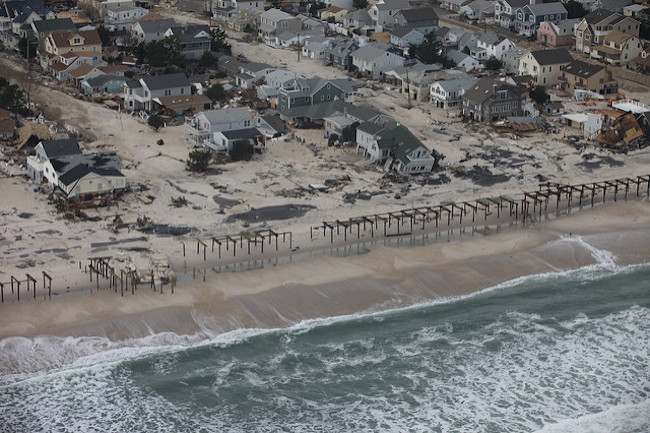
The aftermath of Hurricane Sandy along the New Jersey shore. (Photo: USFWS)
Suddenly I found myself on the front lines of a climate crisis that had arrived 100 years earlier than expected. For a long time I’d seen climate change only as an environmental issue because environmentalists were always framing it in terms of birds, bears and bees, but I’m a fisherman. I kill things for a living. I grew up shooting moose out of my kitchen window. I never thought climate change had anything to do with my life. But it does. From my vantage point, climate change is not an environmental issue at all — it’s an economic issue.
The same years my farm was wiped out by hurricanes, 83,000 people lost their jobs in New York City because of flooding, many of those in manufacturing. Unemployment claims doubled in Vermont along the storm’s path, and 80 percent of U.S. farmland was shriveled by drought, driving up food prices for middle and working class families. It turns out there will be no jobs on a dead planet.
Vertical underwater farming
After my farm was destroyed, it was clear to me that I had to adapt because I was facing a serious threat to my livelihood. I began to re-imagine my occupation and oyster farm. I began experimenting and exploring new designs and new species. I lifted my farm off the sea bottom to avoid the impact of storm surges created by hurricanes and started to grow new mixes of restorative species. Now, after 29 years of working on the oceans, I’ve remade myself as a 3D ocean farmer, growing a mix of seaweeds and shellfish for food, fuel, fertilizer and feed.
That’s how I got to where I am today. Now let’s dive in and take a look at the farm and deconstruct why it’s designed the way it is. Imagine a vertical underwater garden with hurricane-proof anchors on the edges connected by floating horizontal ropes across the surface. From these lines kelp and Gracilaria and other kinds of seaweeds grow vertically downward next to scallops in hanging nets that look like Japanese lanterns and mussels held in suspension in mesh socks. Staked below the vertical garden are oysters in cages and then clams buried in the sea floor.
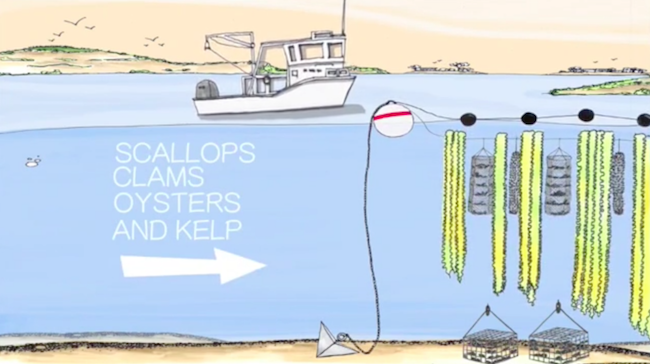
(Image: gizmodo.com)
If you look for my farm from ashore, there’s almost nothing to see, which is a good thing. Our underwater farms have a low aesthetic impact. That’s important because our oceans are beautiful pristine places, and we want to keep them that way. Because the farm is vertical, it has a small footprint. My farm used to be 100 acres; now it’s down to 20 acres, but it produces much more food than before. If you want “small is beautiful,” here it is. We want ocean agriculture to tread lightly.
Our 3D farms are designed to address three major challenges: first, to bring to the table a delicious new seafood plate in this era of overfishing and food insecurity; second, to transform fishermen into restorative ocean farmers; and third, to build the foundation for a new blue-green economy that doesn’t recreate the injustices of the old industrial economy.
Eating like fish and transforming an entire workforce
First: food production. As ocean farmers, we reject aquaculture’s obsession with monoculture, an obsession similar to that of modern land farming. Our goal is diversity. It’s a sea-basket approach: we grow two types of seaweeds, four kinds of shellfish, and we harvest salt. But with over 10,000 edible plants in the ocean, we’ve barely scratched the surface. We eat only a few species, and we grow basically none in the United States. We intend to de-sushify seaweed and invent a new native cuisine, not around our industrial palate of salmon and tuna but around the thousands of undiscovered ocean vegetables that are right outside our backdoor.
Native seaweeds contain more vitamin C than orange juice, more calcium than milk and more protein than soybeans. It might surprise those of you on the hunt for Omega-3s to learn that many fish do not create these heart-healthy nutrients by themselves — they consume them. By eating the plants fish eat, we get the same benefits while reducing pressure on fish stocks. So it’s time that we eat like fish.
We’re working with chefs to cook up kelp noodles with parsnips and bread crumbs in barbeque sauce; green sea butters and cheeses; kelp-based umami-filled bouillons. Our new ocean dinners are fun, they’re creative and they’re delicious. This is our opportunity to rearrange the seafood plate by moving ocean plants and bivalves to the center and wild fish to the edges. Imagine being a chef in 2015 and discovering that there are thousands of vegetable species you’ve never cooked with. It’s like discovering corn, arugula, tomatoes and lettuce for the first time. As one of my partner chefs — and the former punk-rock drummer — Brooks Headley, says, “As a chef it feels frightening, daunting, and exciting all at once.” Ocean greens such as kelp are not small boutique crops. We can grow incredible amounts of food in small areas: 25 tons of greens and 250,000 shellfish per acre in five months. If you were to create a network of our ocean farms totaling the size of Washington state, you could feed the planet.
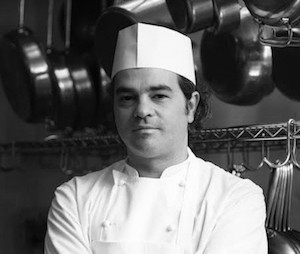
Musician and chef, Brooks Headly. (Photo: WW Norton)
This is zero-input food that requires no fresh water, no fertilizer, no feed, no arid land. It is hands down the most sustainable food on the planet. And as the price of fertilizer, water and feed goes up, zero-input food is going to be the most affordable food on the planet. The economics of it will drive us to eat ocean greens. The question is, will it be delicious food or will it be like being force-fed cod liver oil? As farmers, it’s our job to grow this new cuisine, and for chefs it’s their job to make it tasty.
Ocean farming isn’t just about food. It’s about transforming an entire workforce, transforming fishers into restorative ocean farmers. My job has never been to save the seas; it’s to figure out how the seas can save us. I say that because millions of years ago Mother Nature created two technologies designed to mitigate our harm: shellfish and seaweeds. Oysters filter up to 50 gallons of water a day, pulling nitrogen — the cause of our oceans’ spreading dead zones — from the water column. Our farmed kelp, called the Sequoia of the sea, soaks up five times more carbon than land based plants. Seaweeds are a powerful source of zero-input biofuel; we can produce 2,000 gallons of ethanol per acre — that’s a 30 times higher yield than soybeans and five times more than corn. According to the Department of Energy, if you were to take a network of our farms equaling half the size of the state of Maine, you could replace all the oil in the United States.
Our farms function as storm-surge protectors, breaking up wave action to reduce the impact of hurricanes and rising tides. And they serve as artificial reefs, attracting more than 150 species of aquatic life. Sea horses, striped bass and grey seals come to eat, hide, and thrive on our farms. My farm used to be a barren patch of ocean, now it’s a flourishing ecosystem. As fishermen, we’re no longer pillagers, hunting the last fish. We are a new generation of climate farmers who have joined the fight to restore our planet. We’re trying to break down the seawalls that separate our land-based and ocean-based food systems. Even the best land-based farms pollute, sending nitrogen into our waterways, so we use our kelp to capture that nitrogen, turn it into liquid fertilizers and send it back to organic farmers to grow their wonderful vegetables. When the nitrogen then runs back into Long Island Sound, we capture it again.
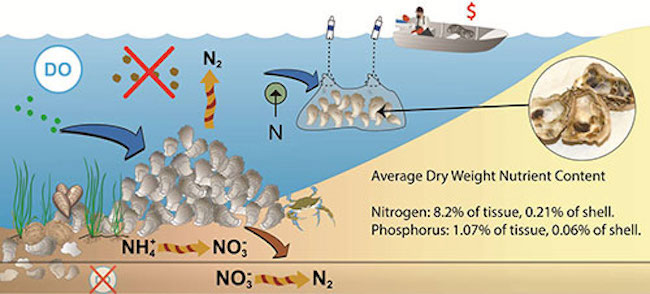
Natural reef and aquaculture oysters act as natural filters to reduce nitrogen, phosphorus, and sediment levels in the water column. (Image: Maryland Department of Natural Resources)
We are also working on new forms of livestock feeds. For example, when cattle are fed a majority kelp-based diet, there is a 90 percent reduction in methane output. The idea is to build a bridge between land and sea in order to close the loop between our food systems. Too often our thinking stops at the water’s edge. A bridge is needed.
The blue-green economy
Our goal is to build a just foundation for the blue-green economy. Saving the seas is not enough. There is 40 percent unemployment in my hometown. I wouldn’t be doing this work unless it created jobs for my people, unless it opened up new opportunities for the three billion folks who depend on our oceans to make a living.
Our old economy is crumbling. I can’t get cell service in half of the country, let alone decent healthcare or a healthy meal. The old economy is built on the arrogance of growth at all costs, profiting from pollution, and the refusal to share economic gains with 99 percent of Americans. But out of the ashes of the old economy, together we are building something new based on new-economy principles of collaboration, community-driven innovation, shared profits a and meeting social needs. Because ocean agriculture is still in its infancy, we have the unprecedented opportunity to build a model from scratch, to build from the bottom up an economy that works for everyone, not just a few. We have the opportunity to learn from the mistakes of industrial agriculture and aquaculture. This is our chance to do food right.
[If you like what you are reading, help us spread the word. “Like” Rural America In These Times on Facebook. Click on the “Like Page” button below the wolf on the upper right of your screen.]
For this to happen, our team at GreenWave, an organization created to build out the new ocean agricultural system and replicate it, is working to address three major questions: First, how do we replicate and scale our farming model so that it doesn’t become a carbon copy of industrial factory farming? Second, how do we build the infrastructure to create new ownership models to ensure that farmers capture the value chain and that the principles of equity and social justice are woven into the fabric of the ocean economy? Third, how do we create new kinds of economic relationships among growers and buyers and consumers?

(Image: greenwave.org)
We addressed the first question of farm replication and scale, not by patenting or franchising — those are tools of the old economy — but by open-sourcing our farming model so that anybody with 20 acres and a boat and $30,000 can start his or her own farm. One of our new farmers is a third-generation lobsterman who was unemployed because climate change had pushed lobsters northward. We got him up and running, growing and selling the first year. Among our other farmers are former Alaskan salmon fishermen, an Iraq war veteran and a Latino family whose ancestors were driven off their farmlands in Mexico. We replicate and scale by specifically designing our farms to require low capital costs and minimal skills. We seek simplicity not complexity. We believe that replication is driven by setting low barriers to entry so that people from all walks of life can grow and prosper with us. At the same time our farmers receive start-up grants, access to free seed, gear donated by Patagonia, and two years of free consulting from GreenWave. What is most important, we guarantee to purchase 80 percent of their crops for the first five years at triple the market rate.
We intend to create stable and secure markets that give our beginning farmers time to learn the trade and to scale up their farms. They keep farming because they know they’ll get paid well for what they grow. Our vision is hundreds of small-scale ocean farms dotting our coastlines, surrounded by conservation zones. Imagine a Napa valley of ocean merroirs dotting out coastlines.
We envision 3D farms embedded in wind farms, harvesting not only wind but also food, fuel and fertilizers. We envision using shuttered coal plants — like the one closing in Bridgeport, Conn. — for processing animal feed and salt. We want to repurpose the fossil-fuel and fishing industries so that they will protect rather than destroy our oceans.
Getting out of the boutique food economy and recreating an industry
The second question is how to build the infrastructure needed to ensure that ocean farmers and communities will reap the rewards of the blue-green economy. For too long, farmers and fishermen have been caught in the beggar’s game of selling raw commodities while others soak up the profits; too many of us are locked in the boutique food economy, selling as CSAs and at farmer’s markets, with the majority of us not making an adequate living and having to hold down multiple jobs to make ends meet. But now, in our unexplored oceans we have a chance to plan ahead and to build an infrastructure in the right way. One of our new farmers, a 65-year-old fisherman, whose family has fished in Rhode Island for 300 years, put it this way: “The last thing we want to do with 3D farming is re-create the fishing industry.”
Instead of repeating history we’re building infrastructure from seed-to-harvest-to-market. We’re starting non-profit hatcheries so that our farmers can access low-cost seed. We’re creating ocean seed banks so that the Monsantos of the world can’t privatize the source of our food and livelihoods. We cap the price of a sublease at $50 an acre per year so that low-income ocean farmers can access property. But by “property” we do not mean privatization. Our farmers don’t own their patch of ocean; they own only the right to grow shellfish and seaweeds there, which means that anyone can boat, fish, or swim on their farms. I own the process of farming but not the property, and this keeps my farm as shared community space. We’re also building in levers of community control. Leases are up for review every five years so that if I’m farming unsustainably, my rights can be revoked.
At the same time, we’re building the country’s first farmer-owned seafood hub, which is not only a place to process, package and ship the raw commodities we raise but also a space to leverage the unique qualities of our seaweeds. The power of kelp is that it’s not just food; there is a whole range of products we can produce that meet environmental and social needs: organic fertilizers, new livestock feeds, kelp biofuels, and even medicine. With thousands of yet undiscovered ocean plants, farmers and scientists can join together to discover and grow new forms of medicine.
Pushing injustice off the table
If we provide our communities with the right mix of low-cost, open-source infrastructure, our hub will become an engine for job creation and the basis for inventing new industries. It will also be an engine for food justice, a place where we embed good jobs, food access and nutrition into the structure of ocean agriculture. This means, for example, working with local grassroots groups like CitySeed in New Haven, Conn., to ensure that low-income folks can use food stamps to carry double the value at our Community Supported Fisheries (CSFs) and our Beyond Fish retail store. It also means using our hub as a hiring hall where local workers can find jobs on our farms, in our start-ups and in our kitchens. If you come to the hub for a job, don’t bring your resumé. We don’t care if you are a former felon or an undocumented immigrant; we’re going to put you to work.

Ocean farming in progress. (Photo: Caryn B. Davis)
The final challenge is how to re-arrange the relationships between those of us who produce food and those of us who buy it. Failure would be to recreate the power dynamics of the old economy. Just as we need to re-arrange what’s on our dinner plates by moving ocean greens to the center, we need to move farmers, food workers, communities and protection of the planet to the center of our plate, and push the destructive, unjust old economy off the table. We’re putting farmers and buyers on equal footing by negotiating with institutions to guarantee forward contracts so that we get paid before we grow, and if our crops fail, then both the farmer and the buyer share the loss. It’s time for everyone to share the risk in the risky business of growing food in the era of climate change and globalization.
The relationship between farmer and buyer has to go even deeper. Reformatting the food system is going to be costly. It’s going to be complex. Simply using purchasing power will not be enough. Anchor institutions such as hospitals, universities, wholesalers and retailers have a new role, a new set of responsibilities in the new economy. They have a duty to invest aggressively in our farmers, our infrastructure and our communities. This involves donating a portion of their profits and their endowment to building hatcheries, seafood hubs, logistical and transport systems, incubation, and R&D. This will mean less profit for the private sector and a lower rate of return for universities. But it will also mean more value in terms of social and environmental good. All around us we can see that “business as usual” will not save this planet. It’s time to divest from the old economy and invest in the new.
The New Economy: Rethinking “The Politics of No”
Finally, we are insisting that markets reward the positive externalities of our farms. We’re working in places like Connecticut to include ocean farmers in existing nitrogen trading programs. New farms are being built in polluted areas like Bridgeport and the Bronx River in order to soak up the nitrogen and carbon, pull out heavy metals and re-build reefs. Instead of harvesting food, these farms harvest ecosystem services. While others pollute, we restore — and as farmers we should be paid for the positive externalities of our work. In the new economy, markets have to reflect the environmental benefits we provide.
In 1979, Jacques Cousteau, the father of ocean conservation, wrote: “We must plant the sea and herd its animals using the ocean as farmers instead of hunters. That is what civilization is all about — farming replacing hunting.” This dream of Cousteau’s and of Green Wave’s is frightening to some environmentalists. The idea of hundreds of ocean farms dotting our coastlines and the idea of 3D farms embedded in wind farms are unsettling to many because of the scale. As a result, the instinct of environmentalists is to do everything they can to protect the oceans from any and all forms of economic development. They shield themselves with a “politics of no.” I’m sympathetic to these fears, especially given the history of industrial aquaculture in the 1980s; yet in the era of climate change, it’s an illusion for environmentalists to think they can save our seas by relying on a conservation strategy alone while continuing to ask the oceans to feed our hunger for wild seafood.
Conservation represents its own form of climate-change denial. We all know it’s real, but the true significance, the implications, the urgency, haven’t sunk in. Just look at what’s happening on land and sea: rising water temperatures and acidification threatening one out of four marine species with extinction; drought and extreme weather expected to make U.S. corn prices go up by 140 percent in the next 15 years alone, while agriculture is responsible for one-third to one-half of all carbon emissions and uses 80 percent of the fresh water in some areas, making it the primary cause of droughts, rising food prices, and food insecurity.
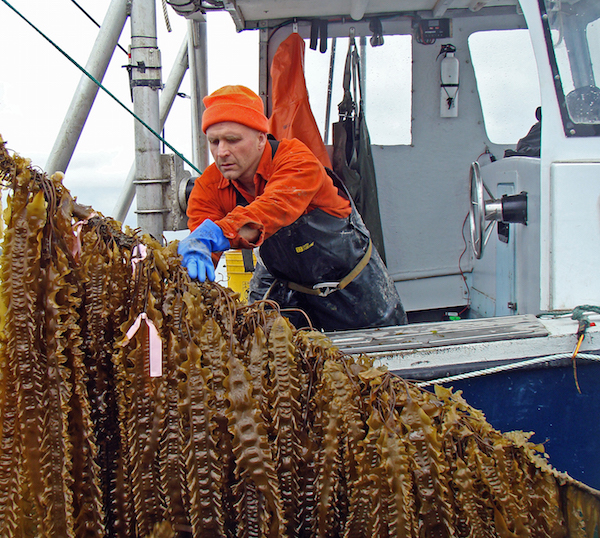
There are over 10,000 edible plants in the ocean. (Photo: greenwave.org)
If there is one lesson we should learn from the 2015 water wars in California, it’s that our food system is going to be driven out to sea. Yes, we need marine parks, but we could set aside the entire world’s oceans, and our ocean ecosystems would still die. Conservation alone is no longer environmentalism.
The climate crisis demands that we use our fears as a catalyst for change. For the first time in generations, we have an opportunity to grow food the right way, provide good middle-class jobs, restore ecosystem and feed the planet.
This is the new face of environmentalism. As our food system gets pushed out to sea, we can come together to block privatization, to protect our commons and to spread the seeds of justice. We can invent new occupations, shift entire workforces out of the old economy into the new restorative economy. This is our chance to recruit an army of ocean farmers to grow a new climate cuisine that is both beautiful and hopeful so that all of us can make a living on a living planet.
This article is a condensed version of Bren Smith’s 35th Annual E. F. Schumacher Lecture entitled Ecological Redemption: Ocean Farming in the Era of Climate Change presented in October 2015. The Schumacher Center for a New Economics has made the full text available online and the lecture can be purchased in pamphlet and eBook form.
